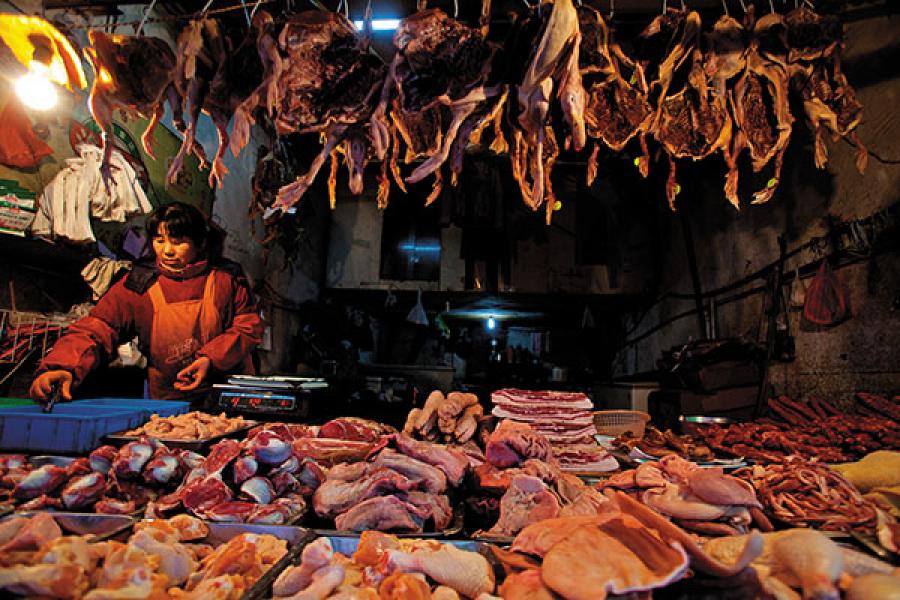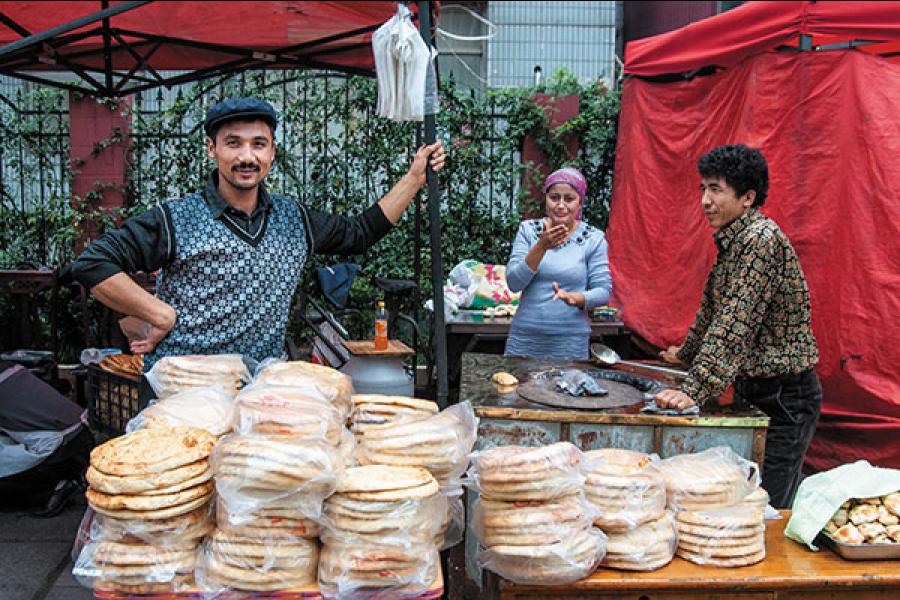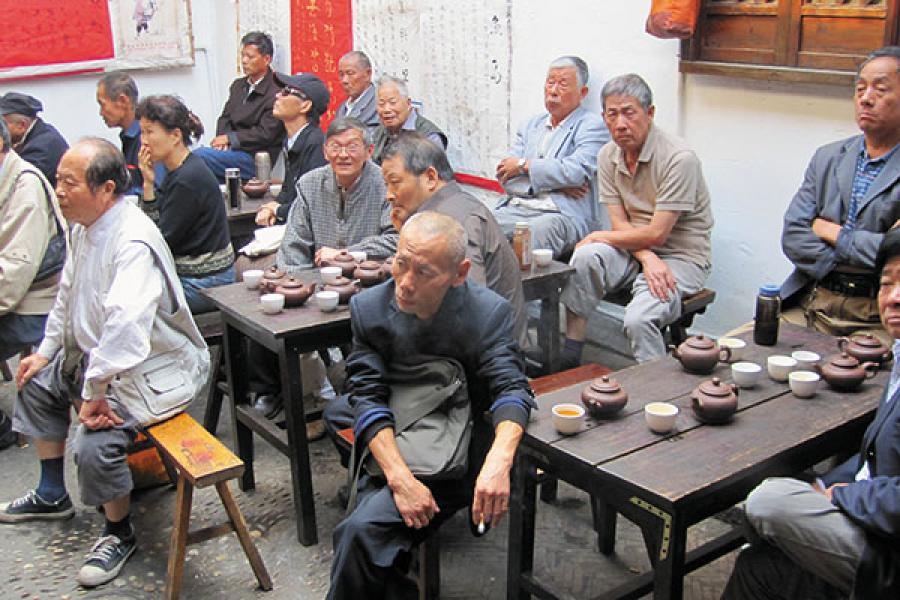
The Food Route to China
Zac O’Yeah follows his nose around Shanghai to discover the country’s alter ego, and its ancient links to India
A cock and two ducks strut about on the pavement in front of a restaurant. Ah, the Chinese obsession with freshness: These ingredients are so brutally fresh!
The supermarket where I pick up groceries during my Shanghai sojourn follows the same game plan: Buckets and trays are full of swimming eels, meditative turtles craning their necks at customers, croaking toads, and crabs (their claws tied) waiting patiently. Until suppertime. It suddenly feels as if my knowledge of Chinese grub before I got here—fried rice, fried noodles, cornstarch and MSG gravies—amounts to nothing.
Take Chop Suey. I discovered, to my consternation, that it isn’t Chinese at all, but was invented in San Francisco around 1888 for the American palate. Although its name stems from the Cantonese jaahp-seui, meaning ‘mixed odds and ends’, it is very rare in China. I never encountered it, but I heard “American” Chop Suey is served at restaurants near foreign embassies, where it is appreciated by the less adventurous diplomats who wish to eat Western-style Chinese food. Western style? So, what’s Chinese-style Chinese food like?
Flashback Time
When I’d just landed, Shanghai appeared impenetrable without a Gold Credit Card: Its streets lined with upmarket restaurants (where you had to reserve an entire room for much-too-lavish banquet dinners) and too many shops—the global protocol of sameness you’d expect in any international city. What the Chinese wear is decided not by Mao, but by Zara, H&M, Tommy Hilfiger, Adidas. You get Starbucks at almost every street corner, and a huge Ikea warehouse looms by the Inner Ring Elevated Road that encircles downtown. “Do you have Ikea in your country too?” a Chinese friend asks, proudly. Later, I walk past a boutique selling Bentley cars, and begin to wonder: What am I doing here? Where is China?
I came looking for something I could connect with and relate to—the China of my dreams, perhaps—but had ended up in a giant, futuristic, Shanghai-sized shopping mall. While you can’t, despite claims to the contrary, see the Great Wall of China from outer space, it is said that Shanghai—6,300 sq km in area, half a kilometre in height—is the only man-made thing visible by the naked eye from the moon.
It’s a surreal experience to be a Flaubertian flaneur in a city growing so fast that it happens right before your eyes: A pavement one day was dug up and turned into a building site by the time I returned to the spot.
Skyscrapers are the in-thing: The more the merrier, the higher the better. Soon, China is going to have more of them than even the US, the motherland of skyscrapers. Some 687 skyscrapers will be inaugurated in China over the next few years; even the smallest rural town wants one, whether it needs it or not. And Shanghai, with its futuristic riverfront skyline hitting the clouds, is skyscraper dreamland. It’s been featured in Michael Winterbottom’s sci-fi flick Code 46 probably because (a) it indeed looks like a cyberpunk movie set, and (b) it affords us a glimpse of the world’s possible megacity future.
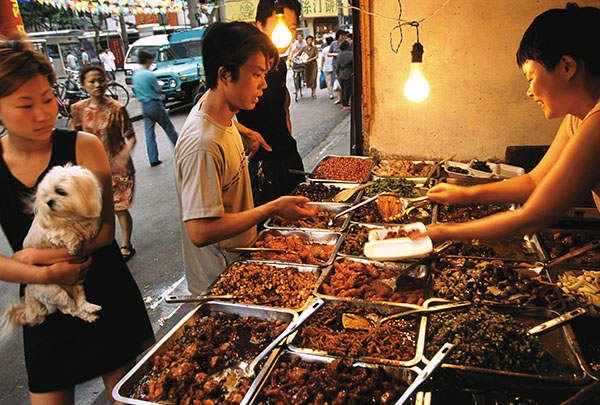
A restaurant in Shanghai’s Zhabei district serving pre-cooked food
Me, I was looking for tradition, for a Chinese way of life. So I hung out in museums, old markets, and small, old-fashioned restaurants without English menus. Understanding people’s food habits helped me to, gradually, understand a bit of the multi-cultural complexity of China. And so, after weeks of feeling lost in the urban jungle, I suddenly caught the scent.
The Uighur Cookout
One Friday I was strolling up Wulumuqi into Jing’an district, through an average inner-city residential area of high-rises when, suddenly, near Suzhou Creek, I smelt something in the air: Slowly grilling meats, seductive spices. Then, around a bend in Changde Road, near the Aomen corner, I spotted the tents.
An ordinary back street, but for its Huxi Mosque, the surroundings of which were transformed, just for the day, into what resembled a Middle Eastern bazaar of makeshift butcher stalls selling halal cuts of fat-tailed Uighur sheep alongside grills roasting shanks and ribs. A cookout of hearty yangrou-chuan skewers, very similar to kebab, but more Chinese-style, with strips of fat lining the meat, which is the way they like to have it that side of the Himalayas.
The peppery curries and specialty polo—Uighur pulao made with shredded carrot, raisins and meat—bring the aromas of the ancient Silk Route to the heart of this modern commercial hub. The freshly baked poppy-seed flavoured flat bread, topped with grilled sheep rack, yellow from saffron, is awesome; a decent-sized helping costs ¥26 (1 China Yuan Renminbi or CNY, is worth roughly Rs 9.60). For a smaller bite there’s a sheep pie, samsa (it’s in-between a mutton samosa and a Chinese dumpling; neither deep-fried nor steamed, but baked).
The Uighurs, ancient pastoralist Turkic speakers, are one of the almost-forgotten links in Asian food habits: Between Chinese, Middle Eastern and Indian. Out of the Chinese population of over one billion, these Sunni Muslims number about eight million; they look a lot like the other Chinese, but are conspicuous thanks to the men wearing knitted skullcaps and wispy beards, and their tasty barbecue.
The food is a fusion of the cultures that came together along the historical trade routes. On the street side, you may see the occasional Uighur chef pull noodles by hand, chop and boil them, and then stir-fry them in a peppery, chilli-spicy beef sauce seasoned with coriander leaves and spring onion. Neither fully Chinese, nor Middle Eastern, a portion of this fusion dish is guaranteed to knock your socks off.
As long as there was a Silk Route, the Uighurs lived in remote oasis towns such as Kashgar on China’s western frontier. But now they have migrated some 5,106 km (according to a scientific Google map calculation) to Shanghai in search of livelihood and a share in China’s prosperity—and they’ve brought their thriving bazaar in an act of existential resilience.
Soon I learn to detect Uighur joints hundreds of metres away from the delicious scents of slowly grilling, marinated meats, and follow my nose to find the bearded old uncles in their skullcaps, roasting their yangrou to perfection.
Shanghai (Con)fusion
Thus, little by little—with food as a springboard to get under the skin of the country—the facades started giving way to hidden treasures.
Shanghai turned out to have two faces: The polished and publicised obscuring, but not obliterating, the old and traditional. I increasingly took to the backstreets, away from the glitz. And there it was, the other China, crouching, behind its skyscrapers, within a web of maze-like alleys, an alternative reality with tiny noodle-soup shops. Which reality is more real? It’s up to the hungry consumer to choose. Because in Shanghai, more than anywhere else, who you are is determined by where you eat and how much you spend.
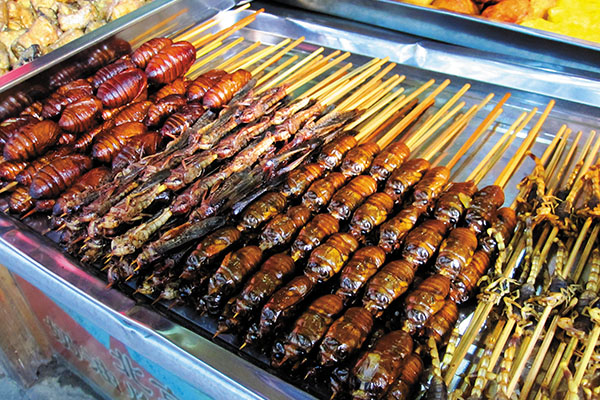
Insect kebabs on display
While on the one hand, people of means feast at rich banquets inside private rooms of high-street restaurants or haunt chic bistros, you can get equally satisfying meals at humble places where the food—for the lack of storage space—is strutting the sidewalk until it is time for the hotpot.
For a modest amount you can gorge on any odd delicacy in Shanghai, from deep-fried silkworms (they taste like juicy prawns) to vegetarian fish—a fish-like, fishy tasting food wholly made of vegetarian ingredients. The latter is a popular sleight of hand in many restaurants, but nowhere more than at the slightly stodgy, old Godly’s at 445 Nanjing Road, where veggie shape-shifting has been turned into a fine art since 1922. If you didn’t know what you were eating, you’d swear it was fish, crab or sea cucumber, but it’s really tofu, or something. Then you wash it down with cheap house wine brewed from rice: Crisp, Riesling-like. Best seafood and white wine I had. Ironically, none of it real.
Nearby, on 473 Nanjing Road, which used to be known as Bubbling Well Road, I explored another rare restaurant, Da Den Westen (note the misspelling of ‘Western’), perhaps the last in town to specialise in the bastardised cuisine that grew out of the colonial period when Shanghai had a substantial British, French, American and Russian population. A century ago there were hundreds of similar restaurants, but now the scruffy Da Den—inaugurated in 1897—is the last one standing. Among the many bizarre dishes on its menu there’s a cheese-baked Portuguese-style chicken curry, a casserole with Asian and European elements.
It perfectly illustrates how Western food was forced to go through transformations to suit Asian conditions and, in the process, turned into something that’s neither here nor there, but can perhaps only exist in cities like Shanghai.
The Kerala Connection
Towards the end of my stay in China, an installation artist takes me out for lunch to a restaurant without an English language signboard; it’s very local. To help me find its location on 458 Jiang Su Lu in a humdrum area called Chang Nin, he sends me a Google map link. When I get there, on the road out in front, boys peddle the latest iPhone weeks before its official release.
The artist guides me through dishes on offer. His favourite cooking style is Cantonese, one of the main food traditions of the country: A southerly seafood-based cuisine that has spread around the world (somewhat in the way that Punjabi cuisine rules Indian restaurants in the West). He especially loves dim sum, which is an array of different snacks, and there is one item in particular that he insists I try—a delicacy called congee.
The name sounds curiously familiar when he speaks it. Indeed, when it is put on the table it turns out to be a Chinese non-veg version of south Indian rice soup, kanji. In Shanghai, it has been made into luxurious seafood porridge, if you can believe it. My friend ladles it on to our platters. “This is the stuff.” An unexpected Indian link slapped right between dumplings and lotus stem preparations.
I spend the next few days trying to figure out this second pan-Asian culinary connection. It appears that congee first entered via Canton—or Guangzhou as it is called now—which has been China’s most important harbour since 7th century AD. And Canton has, of course, long had maritime contacts with the West, including India.
Evidence of these ancient sea links is fairly easy to spot, especially in Kerala, where picturesque old fishing nets (locally known as cheena vala) of a Chinese model dot the backwaters from Kochi to Allapuzha. According to certain theories, the shore-based fishing technique arrived in Kerala with Zheng He, a Chinese diplomat and sea admiral who, in 1406, visited Kerala with 62 ships and nearly 30,000 men. Some of the men stayed back and may have erected the first nets. Later, Zheng sailed to the Persian Gulf. So, in China, he is considered a much more successful explorer than Christopher Columbus (who anyway never found his way to India).

Anyway, kanji is a very traditional dish in south India. A friend from Kerala tells me, “We usually take it with a bit of salt, payaru beans and pappadom. In the olden days, a lot of people used to take it on a regular basis. These days, most people eat it when they’re down with a bad tummy or fever. It’s essentially comfort food.”
Whether it was one of Zheng’s men or some Portuguese sailor who took comfort in the dish and started circulating the recipe, the congee went on to become a popular Chinese dish. It was adapted in different parts of the country and spread to Japan and the Philippines too. (Another international dish domesticated in China’s ports is the Portuguese egg custard pastry, known as dan ta. You get it everywhere in Shanghai.)
Congee is most commonly had for breakfast with fried breadsticks to dip in it, but it can also be part of lunch. When had as a dim sum item, it’s cooked with chicken, pork or seafood, and served as a substitute for rice. But congee isn’t the only Indian word that’s become part of Shanghai vocabulary: The city’s main riverside promenade is called ‘The Bund’, because it was where cargo from India was offloaded and the British opium trading houses were built. The Bund buildings are still standing, but now house posh boutiques and hotels.
It was the discovery of these travelling foods that helped me come to terms with the fact that food, rather than globalised consumerism, is what has tied the world together despite roaring rivers, oceans, deserts and mountains. Over centuries, the Chinese have been communicating with the flavours of India, the Middle East, and even Europe.
It is therefore only right that the Chinese develop congee into a dim sum delicacy, just like in India we’ve spiced up Chinese cooking through the northern school that is sometimes called ‘Sino-Ludhianvi’ and the southern ‘Andhra Chinies’. The latter has possibly been instrumental in popularising Gobi Manchurian, which is sometimes called the unofficial national dish of Bengaluru: Delicious, for sure, the only exception being that no Chinese person would recognise it. For, in China, cauliflower was rare until recently.
A gastronomical epiphany, then, which helped me finally find my connection with China. Whatever we think about globalisation today, its causes and faces, food has always been the great leveller. The fact that I can get a samosa or dumpling with my beer pretty much everywhere in the world means we were truly globalised long before we were told so by the modern world.
(This story appears in the 09 August, 2013 issue of Forbes India. To visit our Archives, click here.)
-
 Dr.a.jagadeesh
Dr.a.jagadeeshI visited China 5 times in the last 12 years. The food on the roadside small restaurants in many cities is cheap. Dr.A.Jagadeesh Nellore(AP),India
on Nov 1, 2013
